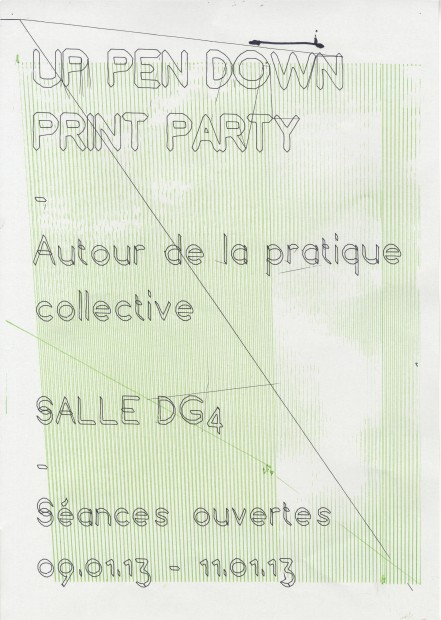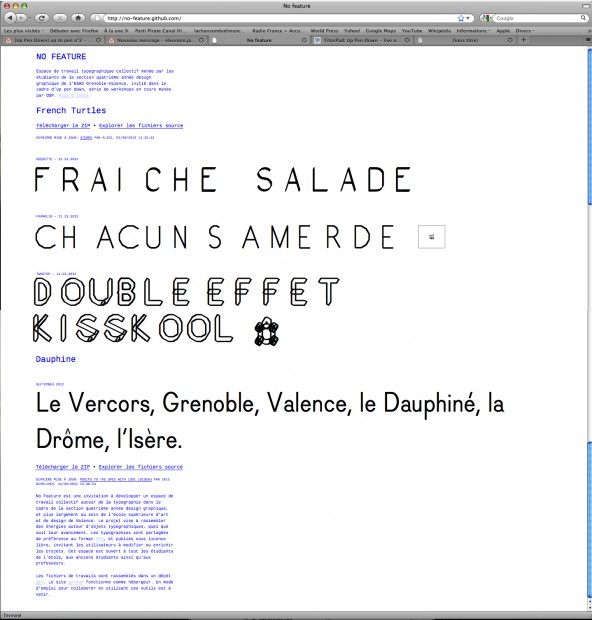Up Pen Down, 2012/2013 invited designers at the ESAD Valence Grenoble
After Metahaven (2008/2009), Åbäke (2009/2010), Paul Elliman (2010/2011) and LUST (2011/2012), OSP are honoured to join the ESAD’s program as invited designers, giving workshops throughout the first semester.
The intervention of OSP is situated around the notion of stroke, in the sense of path—as opposed and informed by the notion of form. Allowing itself to be explored through the different modalities of drawing, typography and cartography, the stroke is intimately related to the tool by which it is drawn, thus influencing the visual language.
As technical, intellectual and cultural constructions, software embodies specific conceptions of the objects they are designed to manipulate (stroke and form, in this case). The PostScript format, for example, describes letterforms by their contour instead of their skeleton. Yet other, lesser known file formats might take an inverse approach.
By virtue of the availability of the source code and more importantly still by the open discussions around their conceptions (mailing lists, collaboration platforms), free and open source software allows the designer the better grasp the implications of the tools for their process.
These are some of the projects developed during OSP’s collaboration with the school:
TURTLE Graphics
The English mathematician Seymour Papert tried to create an embodied understanding of mathematics through his LOGO language. Papert created a language, understood both by humans and computers, that describes drawings not in an absolute cartesian grid, but from the perspective of the person that is drawing. He called this TURTLE graphics.
Using the Seymour extension, we run TURTLE scripts within the vector drawing program Inkscape to create letterforms. We then follow the lead of Papert’s own experiments, by having participants take upon them the role of the turtle, having the others instruct them where to draw.
We use Dishu, the Chinese practice of large scale ephemeral typography with sponges and water, as introduced into the context of occidental graphic design by François Chastanet. In a performance, all students and OSP members present gather in the main hall of the workshop. The first participants leave towards the bridge overseeing the main hall. They instruct the others on how to draw letters. Having drawn a letter, they in turn go to the bridge and instruct others. The words ‘UP PEN DOWN’ are written.
NO-FEATURE Type Foundry
Inkscape is a fine program to create drawings, but does not have the possibility to create font files. Using FontForge we turn the turtle fonts into typefaces.
The NO-FEATURE foundry is a space around typographical exchange and collaboration for (ex-)teachers and (ex-)students of the ESAD. The TURTLE fonts developed during the first session are the first fonts to be published on this platform, along with the typeface Dauphine developed for the school’s identity. Publishing the sources in the UFO format, the fonts invite new contributions and adaptations.
Git, ce connard: Retrospective Publication
A publication documents the four preceding sessions. The publication is created with ConText and a small edition is printed in the school’s printing workshop. Both the PDF version and the source files are available on-line.
Participants
Alexandra Rio, Alice Jauneau, Anaïs Alauzen, Camille Chatelaine, David Vallance, Éléonore Jasseny, Gwenaël Fradin, Jordane Cals, Lorène Ceccon, Margot Baran et Vincent Duché
Bibliography
- Fernand Baudin, L’écriture au tableau noir, Retz, 1984
- Walter Crane, Line and Form, 1900 — http://www.gutenberg.org/files/25290/25290-h/25290-h.htm
- Tim Ingold, Une Brève histoire des lignes, Zones Sensibles, 2011
- Vilém Flusser, “Le geste d’écrire”, in Flusser Studies, n°8, Mai 2009 — http://www.flusserstudies.net/pag/08/le-geste-d-ecrire.pdf
- Donald Knuth, “The Concept of a Meta-Font”, in Visible Language, issue 16.1, January 1982; traduction “Le concept de métafonte”, in Communication et langages, n°55, 1983, pp. 40-53 — http://www.persee.fr/web/revues/home/prescript/article/colan_0336-1500_1983_num_55_1_1549
- Donald Knuth, “Lessons learned from MetaFont”, in Visible Language, issue 19.1, December 1985
- Gerrit Noordzij, The Stroke – theory of writing, Hyphen Press, 2006=
- Femke Snelting, “Scenes of Pressures and relief”, 2009 — http://snelting.domainepublic.net/texts/pressure.txt








